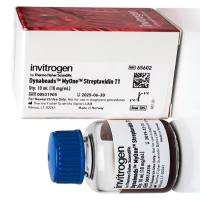Dynabeads® mRNA DIRECT Kit
互联网
实验原理
实验试剂
10 mM Tris-HCl (Elution Buffer)
Magnets: See www.invitrogen.com/magnets for magnet recommendations.
RNase free pipette tips and pipettors.
实验设备
Mixer allowing both tilting and rotation.
Heat block and/or incubator at 65-80°C for elution step (if required).
实验步骤
1. Preparation of Sample Lysate
1) Preparation of Lysate from Solid Plant or Animal Tissue
ii. Grind frozen tissue in liquid nitrogen. Work quickly.
2) Preparation of Lysate from Cultured Cells or Cell Suspension
2. Preparation of Dynabeads® Oligo (dT)25
1) Resuspend Dynabeads® Oligo(dT)25 thoroughly before use.
3) After 30 seconds (or when the suspension is clear), remove the supernatant.
3. Direct mRNA Isolation Protocol
2) Remove the microtube from the magnet and add the sample lysate.






